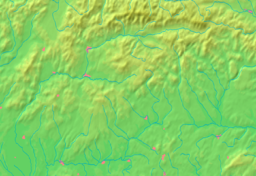Schemnitz
| Banská Štiavnica | ||
| Town | ||
|
The Trinity Square (Námestie Svätej Trojice) in Banská Štiavnica
|
||
|
||
| Country | Slovakia | |
|---|---|---|
| Region | Banská Bystrica | |
| District | Banská Štiavnica | |
| Elevation | 600 m (1,969 ft) | |
| Coordinates | 48°27′29″N 18°53′47″E / 48.45806°N 18.89639°ECoordinates: 48°27′29″N 18°53′47″E / 48.45806°N 18.89639°E | |
| Area | 46.378 km2 (18 sq mi) | |
| Population | 10,662 (2006-12-31) | |
| Density | 230/km2 (596/sq mi) | |
| First mentioned | 1156 | |
| Mayor | Nadežda Babiaková | |
| Timezone | CET (UTC+1) | |
| - summer (DST) | CEST (UTC+2) | |
| Postal code | 969 01 | |
| Area code | +421-45 | |
| Car plate | BS | |
| UNESCO World Heritage Site | ||
| Name | Historic Town of Banská Štiavnica and the Technical Monuments in its Vicinity | |
| Year | 1993 (#17) | |
| Number | 618 | |
| Region | Europe and North America | |
| Criteria | iv, v | |
| IUCN category | Cultural | |
| Statistics: MOŠ/MIS | ||
| Website: www.banskastiavnica.sk | ||
Banská Štiavnica (Slovak pronunciation: [ˈbanskaː ˈʃciawɲitsa]; German: Schemnitz; Hungarian: Selmecbánya (Selmec), pronounced [ˈʃɛlmɛd͡zbaːɲɒ]) is a town in central Slovakia, in the middle of an immense caldera created by the collapse of an ancient volcano. For its size, the caldera is known as Štiavnica Mountains. Banská Štiavnica has a population of more than 10,000. It is a completely preserved medieval town. Because of their historical value, the town and its surroundings were proclaimed by the UNESCO to be a World Heritage Site on December 11, 1993.
The fate of Banská Štiavnica has been closely linked to the exploitation of its abundant resources of silver ore. According to evidence from excavations, the site was settled during the Neolithic period.
The first mining settlement was founded by Celts in the 3rd century BC. It was probably occupied by the Celtic Cotini tribe. Roman authors mentioned mining activities of the Cotini, who had lived in present-day central Slovakia until they were deported to Pannonia within the Marcomannic Wars by Rome. The site was also settled by early Slavs and a Slavic fortified settlement was situated here in the 10th and 11th century. The site was called “terra banensium” (the land of miners) as early as in 1156. The local population gave the name „Štiavnica“ (acidic stream) to the settlement in the valley, and the settlement on the hill above (Ligotavá hora, or Glanzenberg – the shiny mountain) came to be called „Bana“ (the mine). The single common name „Schebnyzbana“ was documented for the first time in 1255. The local Slavic population was joined by skilled German settlers who started arriving in the 13th century. They adapted the local name to the German "Schemnitz". Banská Štiavnica gained the status of a royal town in 1238, as one of the first towns in the Kingdom of Hungary.
...
Wikipedia






